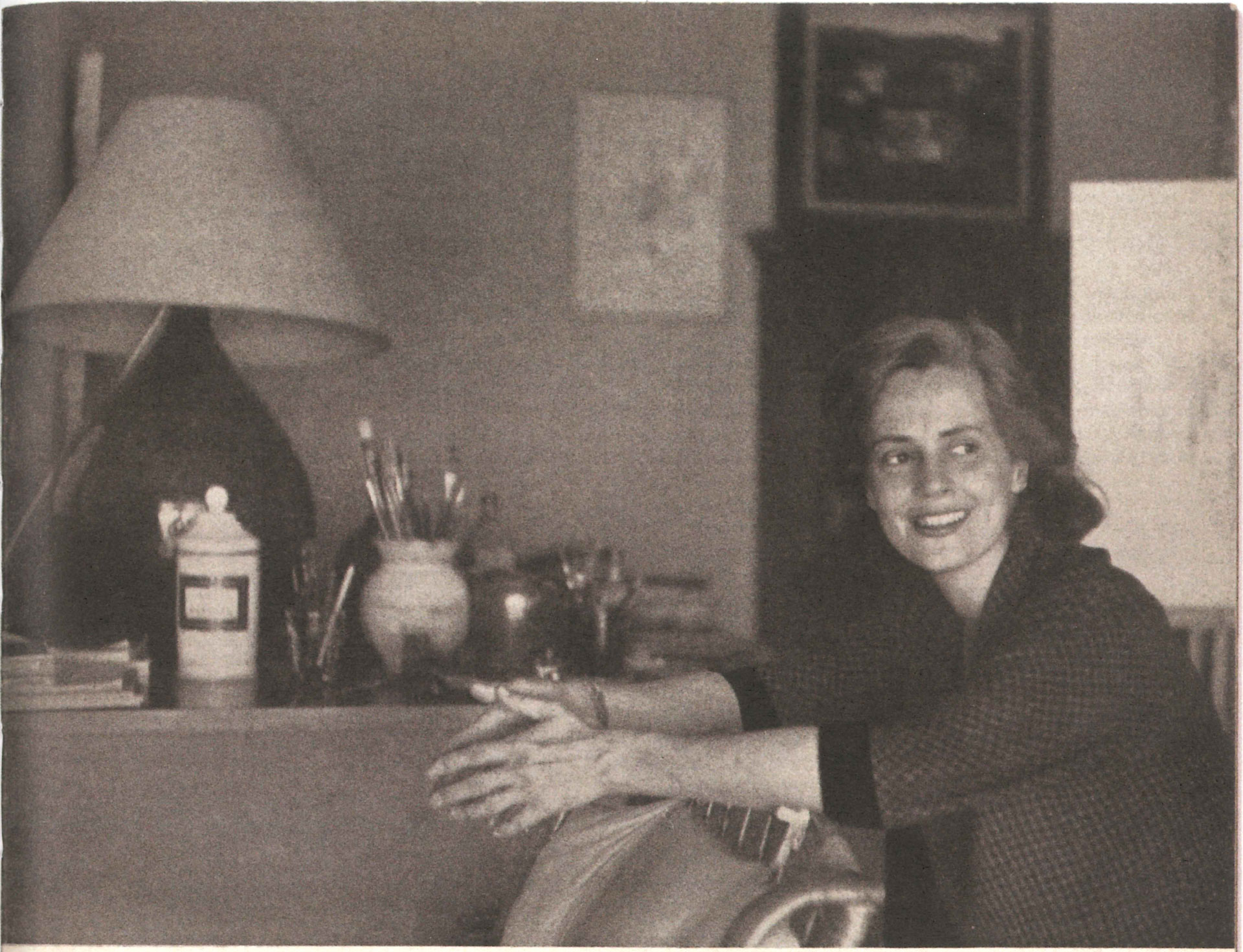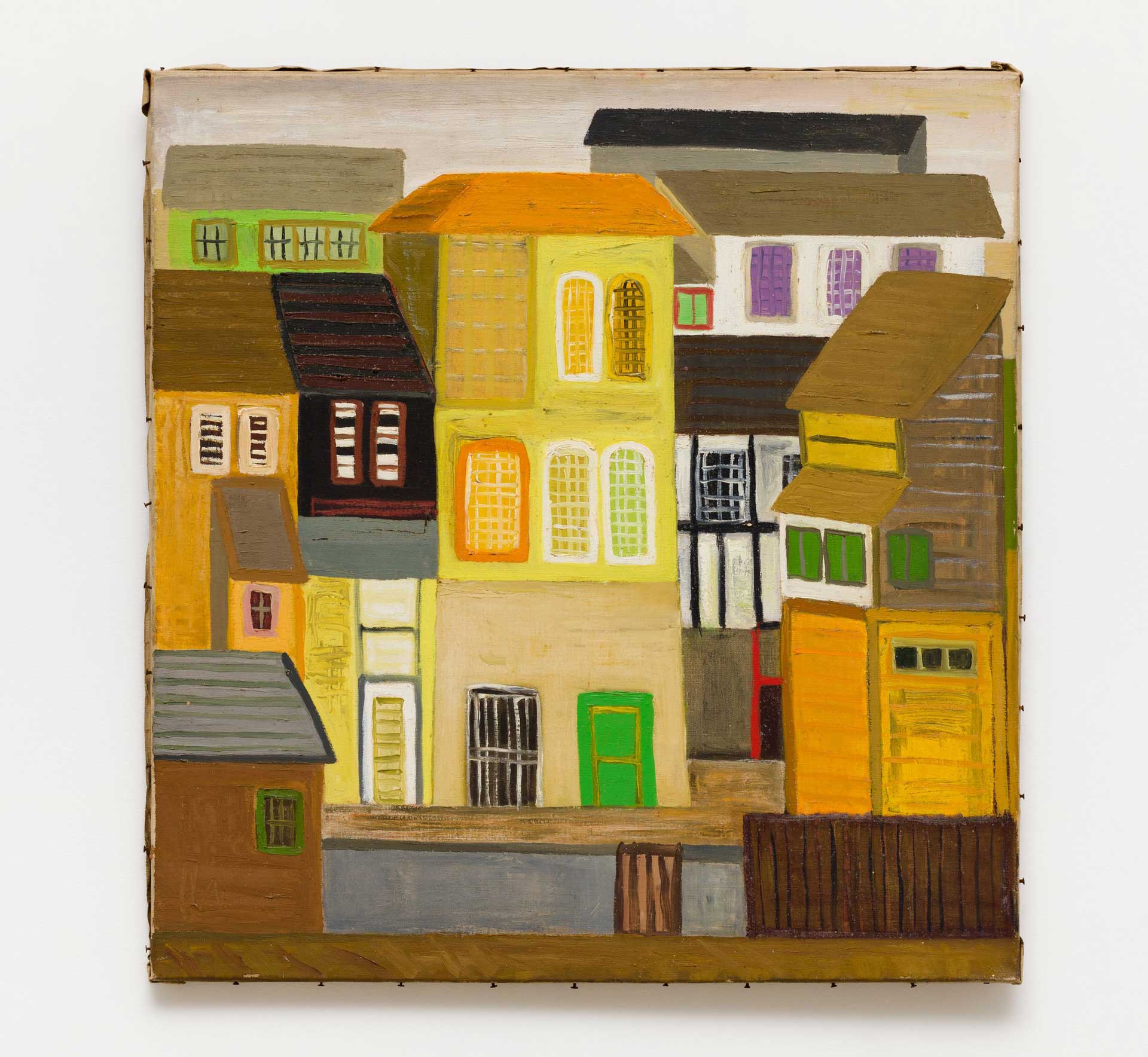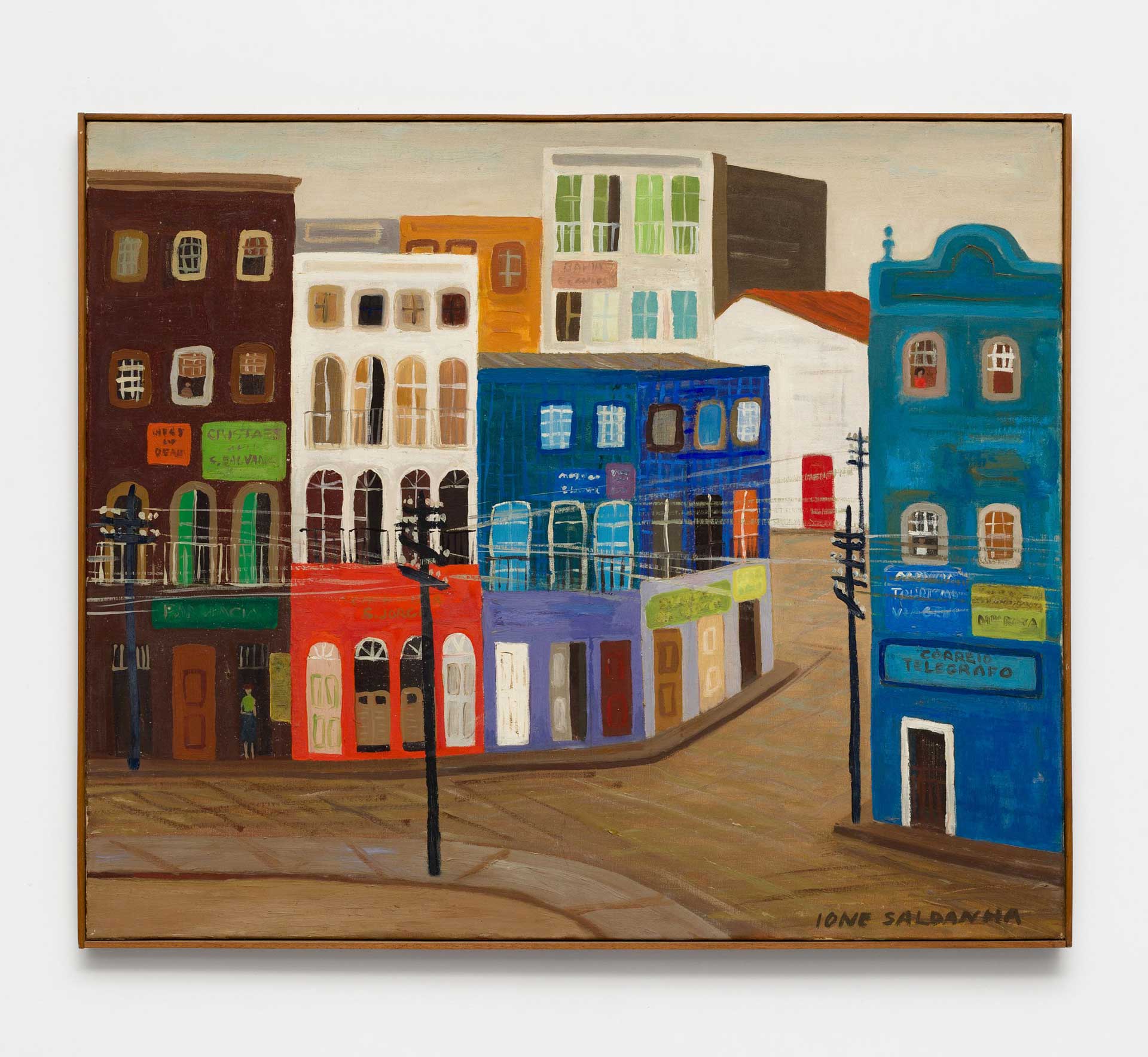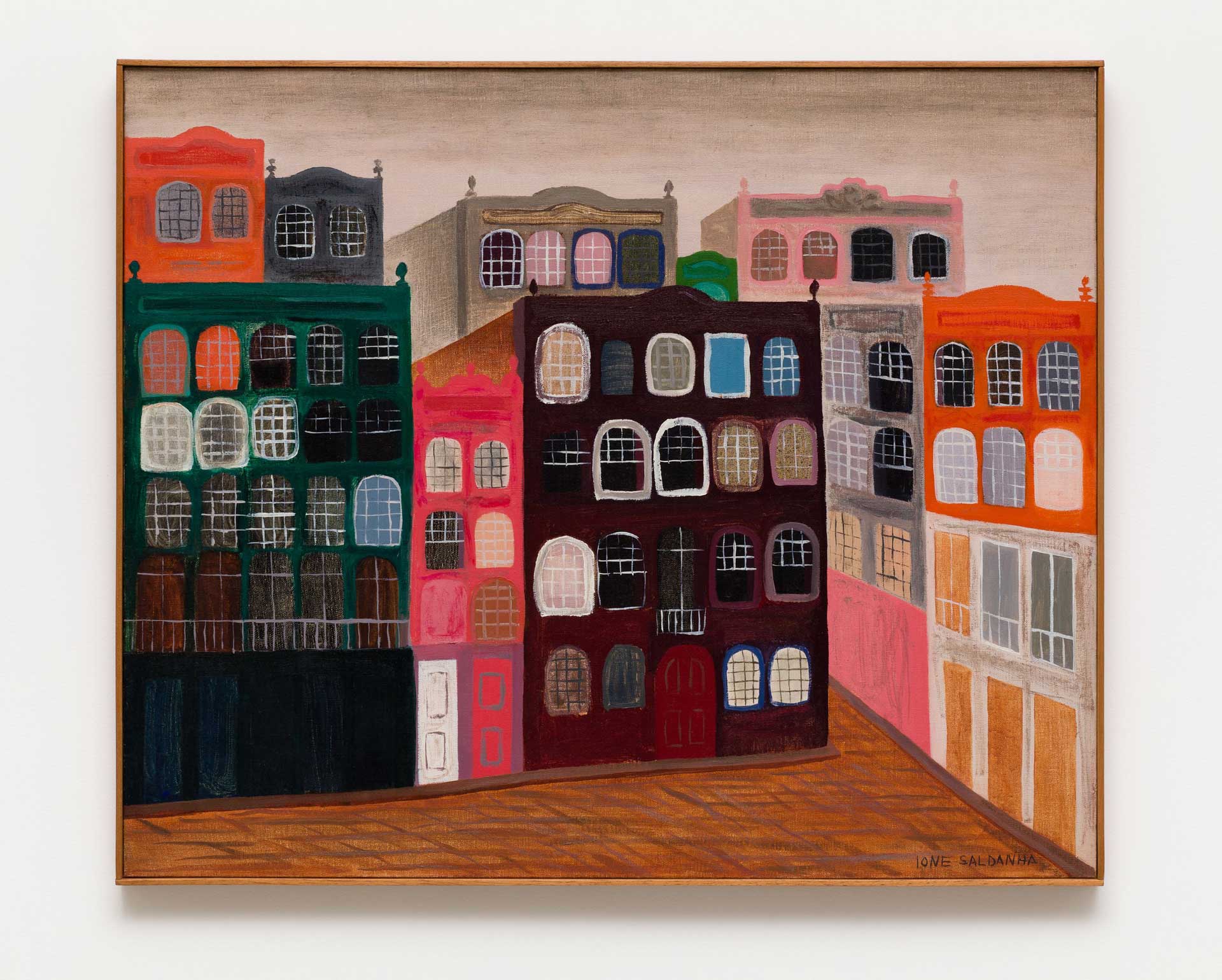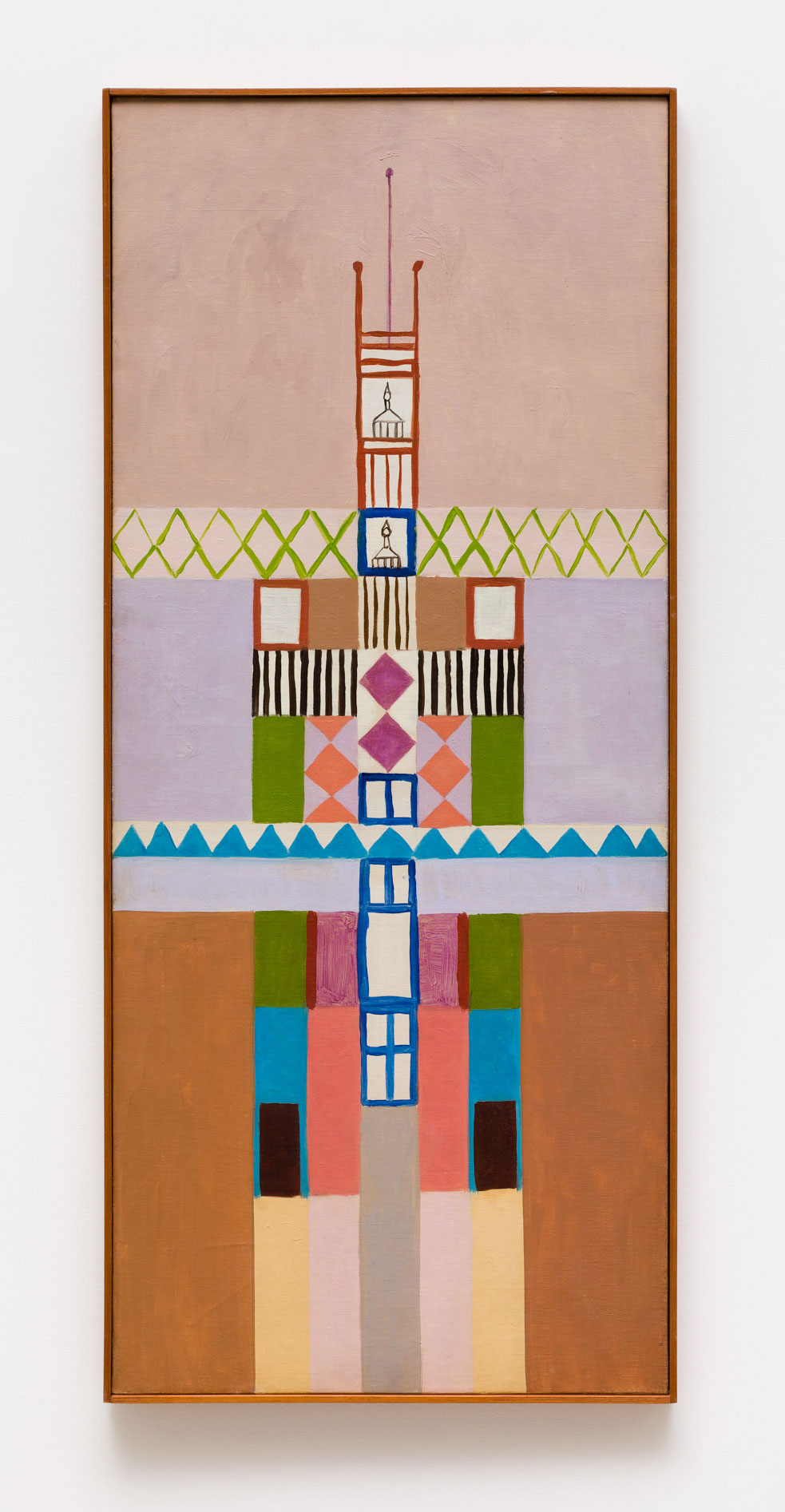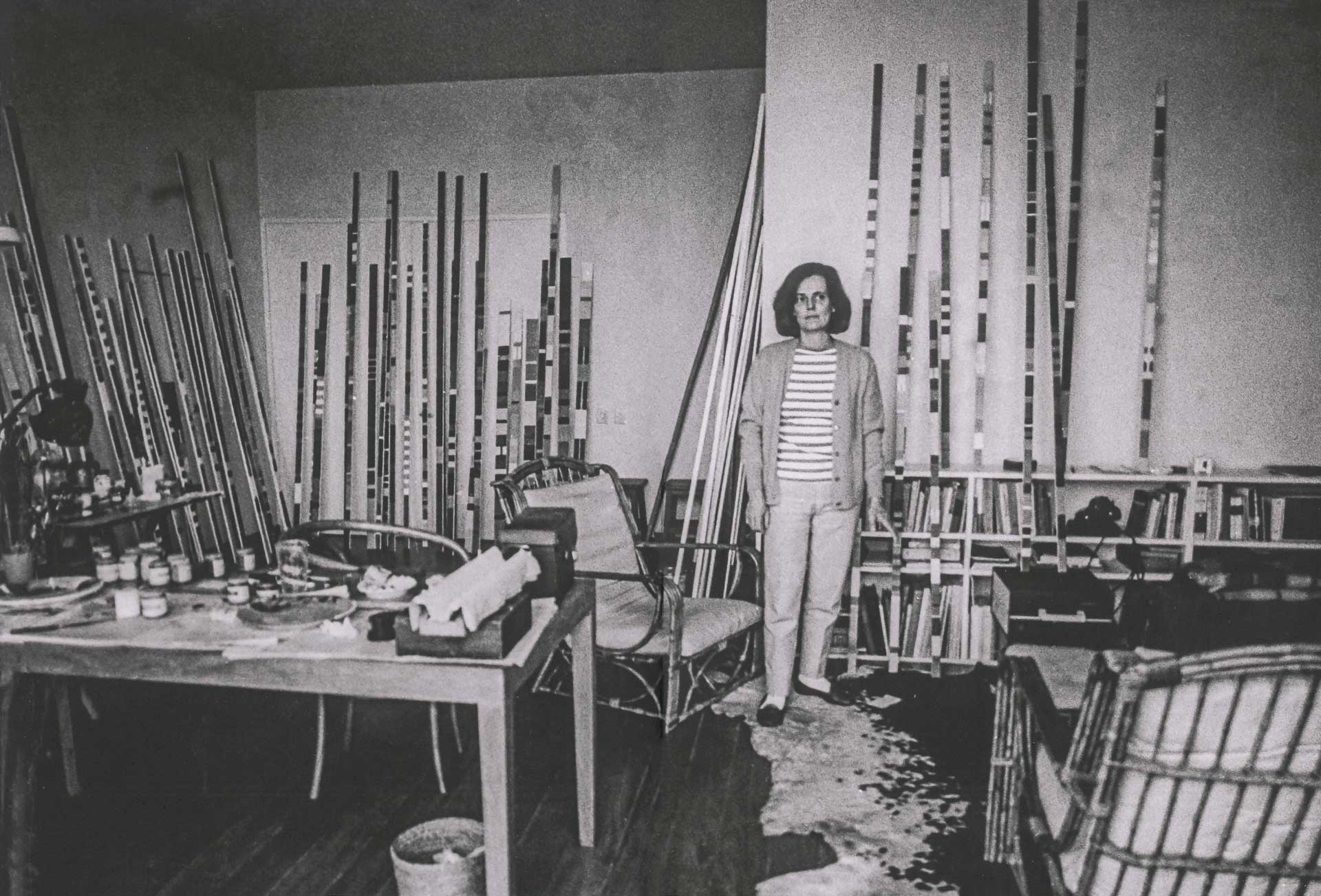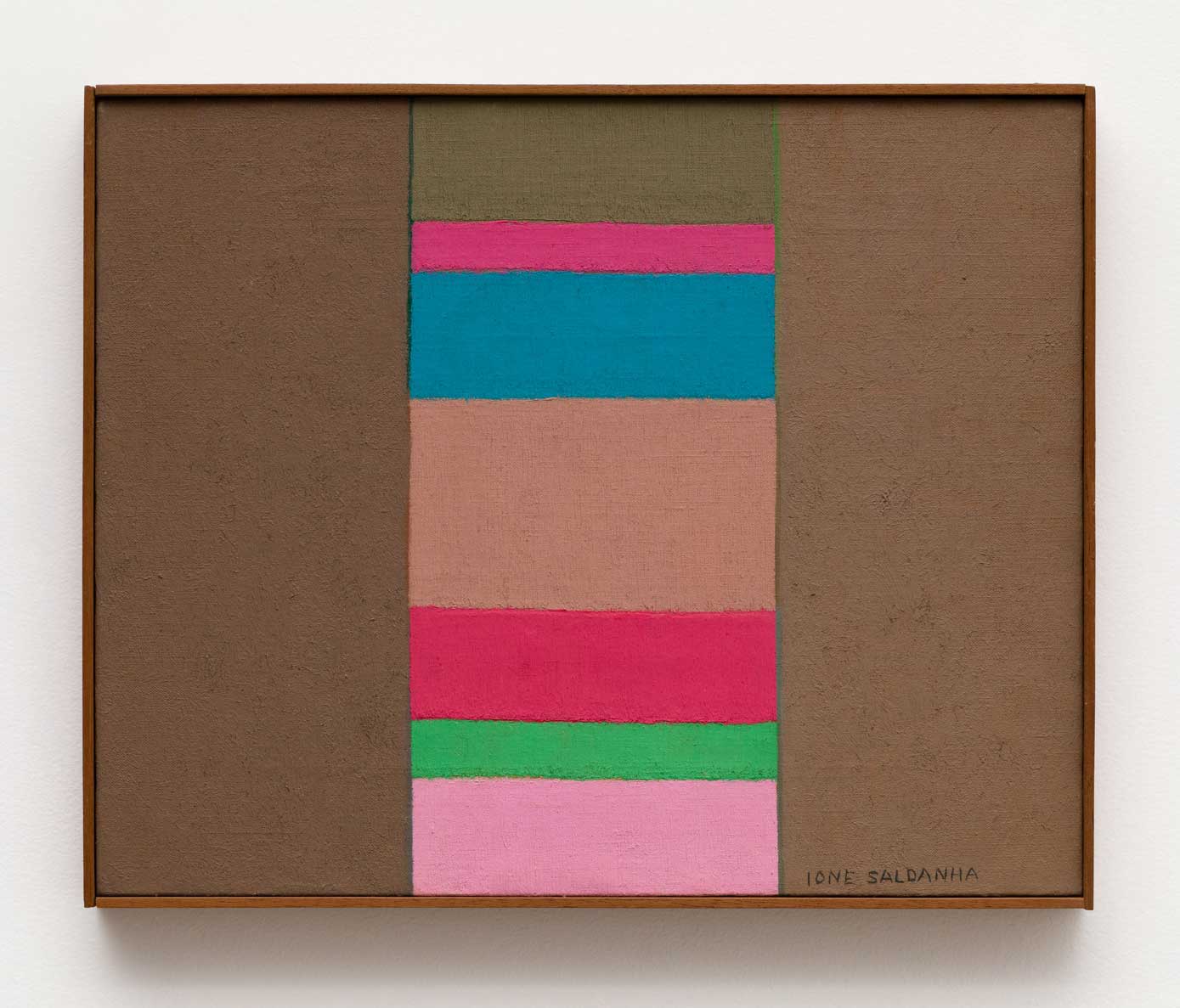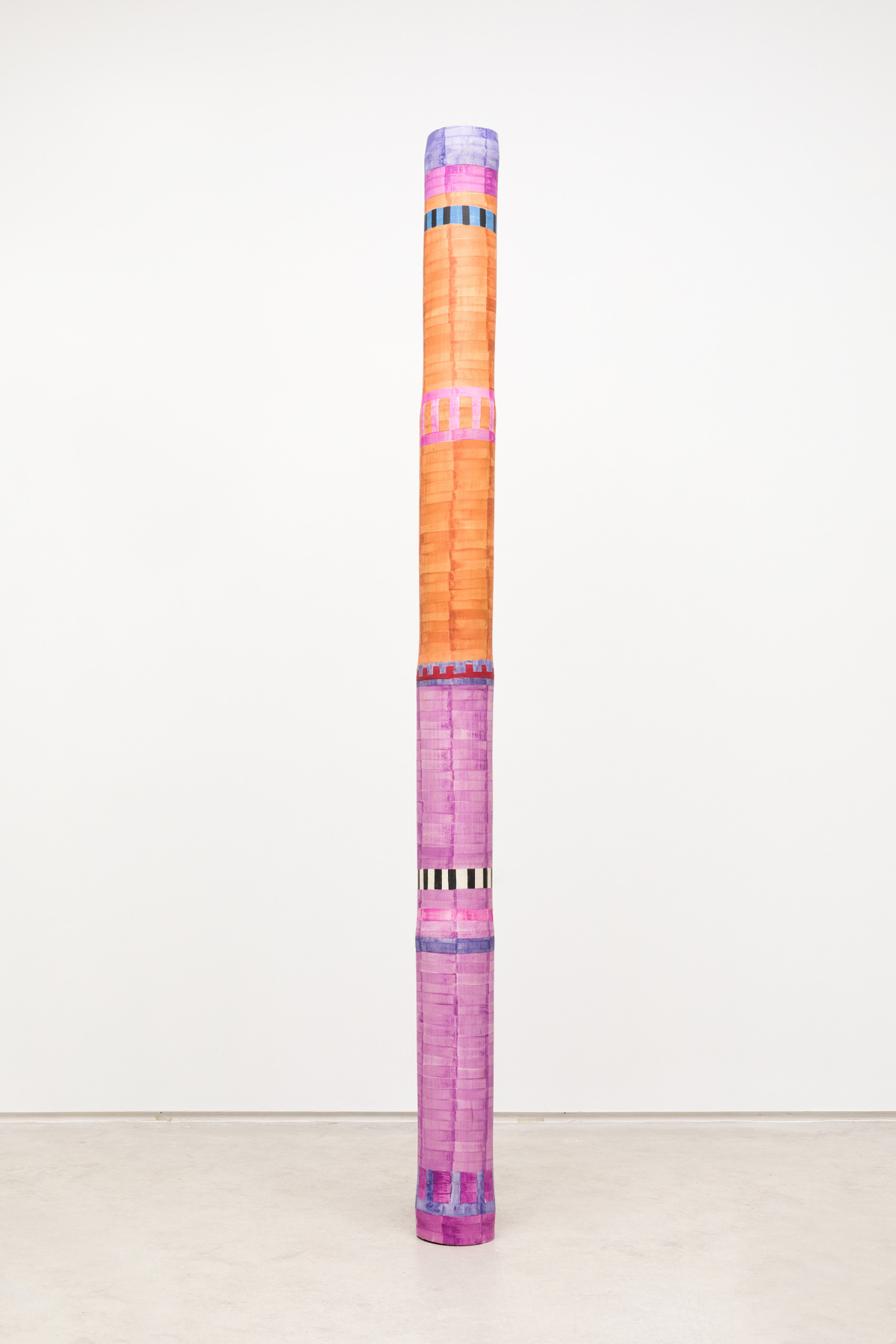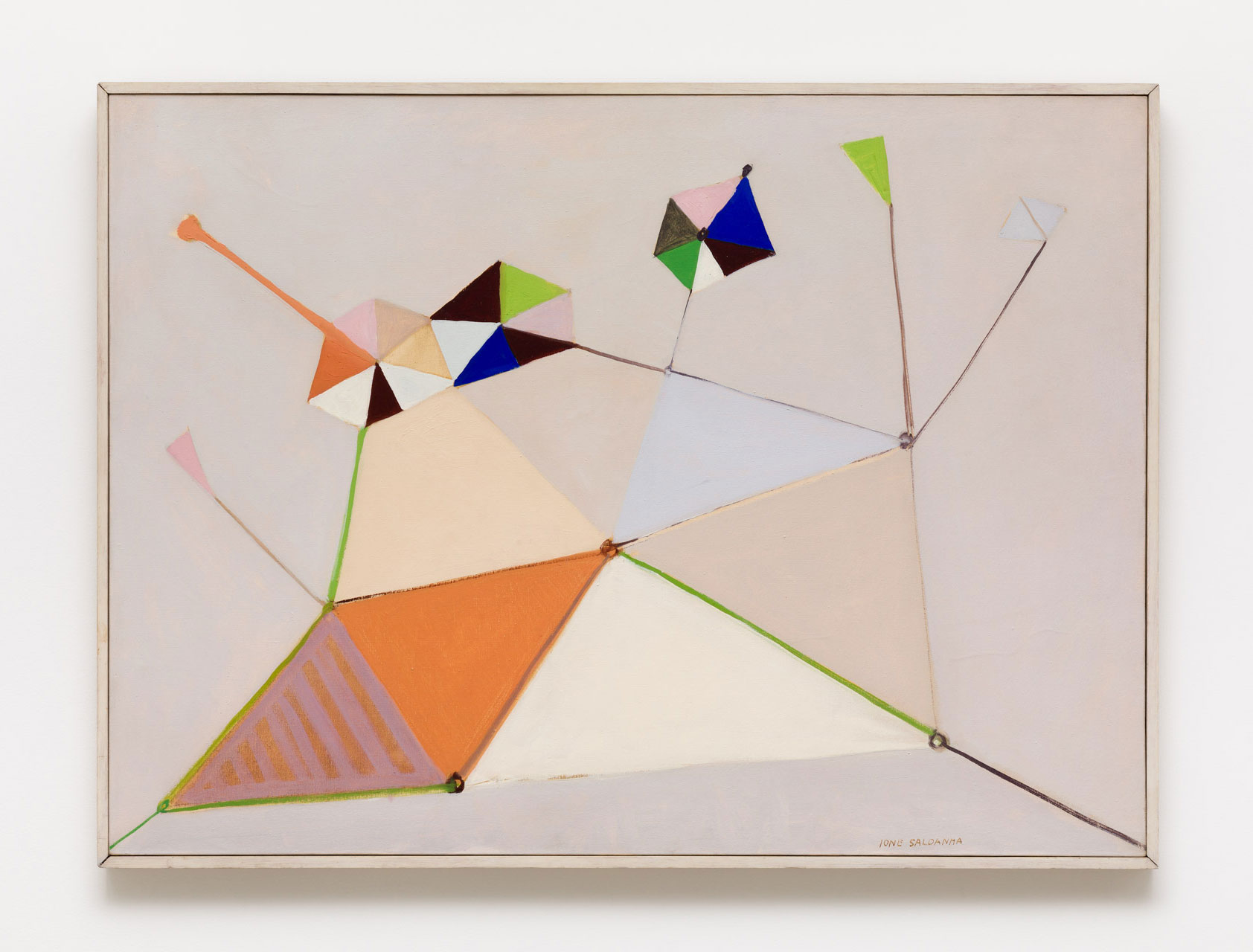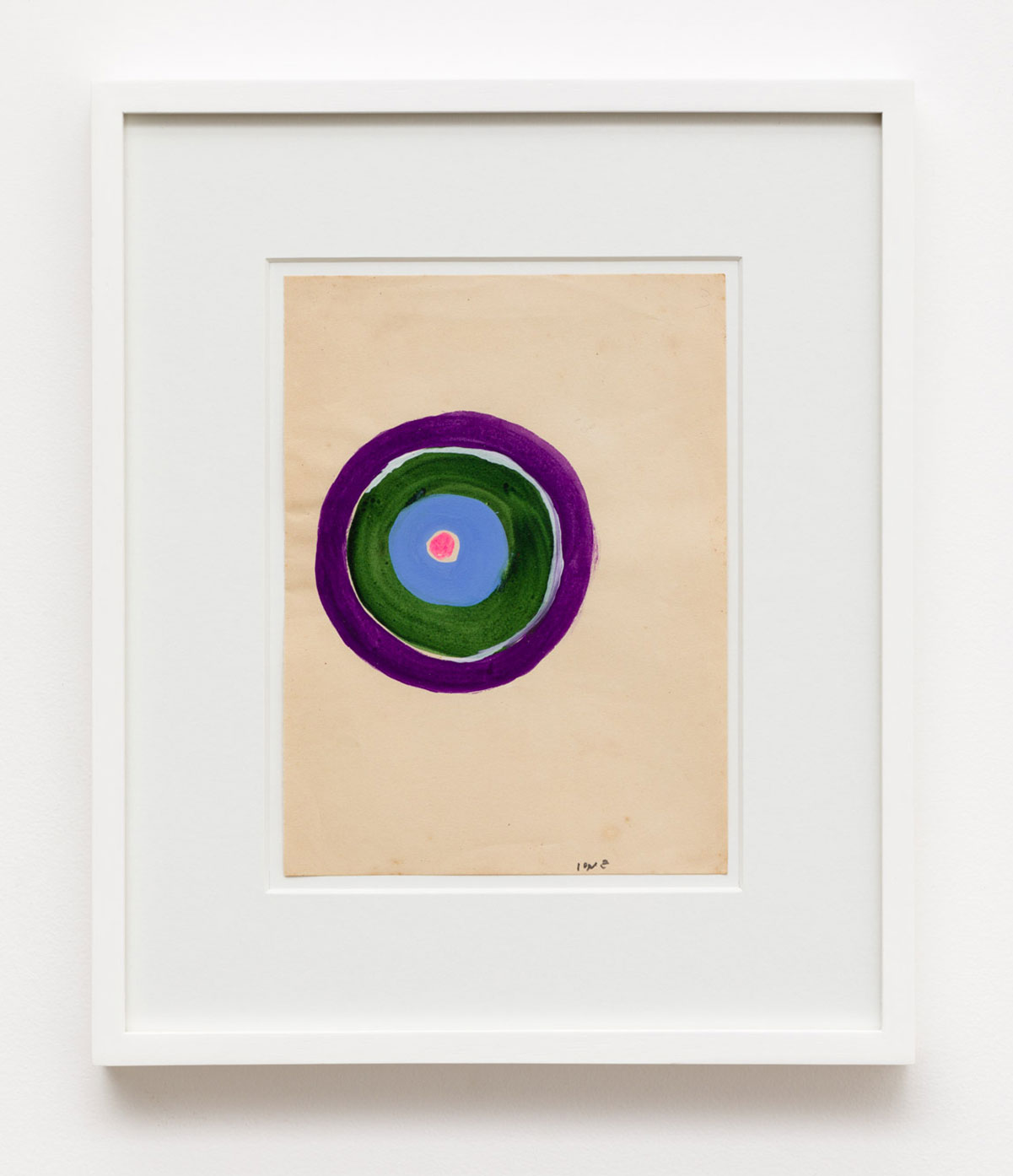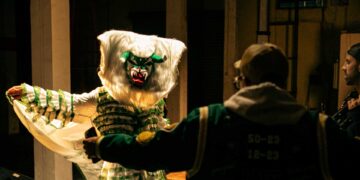Spanning decades of artistic production, Ione Saldanha expanded her visual language and firmly positioned painting within the realm of the amplified field, blending an architectural sensibility with luminous, chromatic compositions. Much has already been written about her work, yet it remains far from exhausted—her practice continues to feel fresh, consistent, fertile, and deeply relevant in light of contemporary concerns.
Ione Saldanha at her studio. Unknown photographer. Courtesy of Simões de Assis Gallery.
In 1949, on the eve of a trip to Europe, Saldanha made a radical decision: she stacked her canvases in the backyard and set them on fire. The fire burned for days, releasing a terrible smell. Only a few oil-on-paper works survived—preserved by her family. This bold gesture was a rejection of conservative, dull, and repetitive art. Saldanha would go on to forge her own path through geometry—not the kind rooted in European constructivism, but a unique approach inspired by the architectural landscape of a Brazil undergoing rapid industrial transformation. In doing so, she challenged the utilitarian logic of technical reproducibility. The act also speaks volumes about her independent spirit and her refusal to conform—to artistic movements, political ideologies, or collective practices.
If we return to the early stages of her poetic language, in the 1940s and 1950s, Ione Saldanha was already revealing an interest in structure through her unique depictions of landscapes from Salvador and Ouro Preto. She captured the subtleties of cultural syncretism through an urban lens—tracing a specific architectural baroque that emerged in Brazil, shaped by both Portuguese and colonial influences. Although cities are forged through human experience, Saldanha’s were notably depopulated—rarely did silhouettes appear. She portrayed clusters of buildings with little or no perspective, flattening them onto the same pictorial plane.
Top left: Ione Saldanha, Untitled, 1952. Oil on canvas, 25 x 23.82 inches. Top right: Ione Saldanha, Untitled, 1953. Oil on canvas, 25.39 x 29.53 inches.
Lower center: Ione Saldanha, Casario bahia, 1950. Oil on Canvas, 25.2 x 30.31 inches.
Cities resemble living organic structures, almost like rhizomatic systems that also reflect a kind of cathartic spirit. While urban grids are initially designed and planned, once materialized, they are inevitably shaped by human intervention, inequality, the elements—by life itself unfolding within everyday economic and political dynamics. Cities are vast human settlements, merging contradictions and vitality, where culture and humanity intertwine to form histories embedded in geographic space.
Saldanha approached cities with this awareness of complexity—a theme that continuously informed her visual thinking and was intimately linked to her central concern: color. She gave color dimension and weight, treating it as material. Her work oscillated between figuration and fragmentation, with forms that evoked architectural symbols and suggested alternate spatial possibilities—cut planes, overlapping layers that invited questions about perspective and orientation. Color was her most profound investigation. Whether painting imagined or referenced cities, she built chromatic modules—stacks of color that formed a poetic universe spanning her canvases, bamboo poles, wooden spools, and slats.
The floating lines were veiled in a mist that dissolved and forged playful traces, multiplying planes between lines and pigments. The artist deconstructed form—beginning with façades, which she cut and reimagined. A façade, after all, could be reduced to a composition of triangles, rectangles, and squares—some works even resemble children’s building blocks. In her paintings, liquefaction dissolves structure, evoking uncertainty: are we seeing a top view, a side view, or perhaps overlapping perspectives? This mist both melts and animates her geometric landscapes.
Ione Saldanha, Untitled (Fachadas), 1956. Oil on canvas, 36.81 x 15.75 inches. Photo: Estúdio em obra. Courtesy of Simões de Assis Gallery.
Verticality is a striking and recurring element throughout her decades of work. It appears in the façades of 1956, the streetlamps of 1947, and the bamboo pieces from the 1970s. A common thread runs through these works—colors already arranged with a similar logic—revealing the artist’s poetic precision, infused with delicacy and formal vulnerability. From the 1950s onward, her brushwork became looser, culminating in a spatial explosion in the 1960s—a bold leap beyond the canvas. She extended the spirit of painting onto new surfaces, blending it with space and nature.
As Ione once said, “One day, I wanted to eliminate the stretcher and the canvas, to escape the rectangle. I was only interested in verticals of color. And, more than anything, in reducing everything to the minimum: a single slat, leaning against the wall, resting on the floor, eliminating even the baseboard.” Her slats have no canvas, no frame, no nails—no structure beyond the painting itself. They simply are what they are.
Ione Saldanha at her studio. Unknown photographer. Courtesy of Simões de Assis Gallery.
Ione Saldanha, Corpo da Cor series, 1966. Oil on canvas, 11.42 x 14.17 inches. Photo: Estúdio em obra. Courtesy of Simões de Assis Gallery.
Saldanha envisioned color leaping into space, forming modular assemblages open to endless possibilities. Her work aimed to remove both painting and sculpture from their pedestals—there is no longer a front, back, or reverse. Everything is the work, everything is occupation, everything is movement.
When faced with these objects, we perceive a deep respect for the continuous process in which life unfolds. The making of the bamboo works is prolonged—from the selection of each piece in nature to the final act of painting. She would first choose mature stalks from the grove—cut during the waning moon, between May and August, when the plant’s sap is low. This organic rhythm merges visual art with the natural world. She let the bamboo dry for a year before piercing it down the center to reduce resistance. Then came sanding. Only after all that would she begin painting, using acrylics. Everything had to be done in a single session—she rejected any kind of patchwork. There was no rushing; speeding up the process meant risking the entire year’s work. She waited patiently, and once the bamboo was ready, she acted with precise intention, trusting her vision to reimagine the object. There was rhythm, appropriation, and a deep respect for time.
Ione Saldanha, Bambu, a.c 1980. Painting on bamboo, 81.5 x 5.1 inches. Photo: Estúdio em obra. Courtesy of Simões de Assis Gallery.
Through surface experimentation, she built a unique and instantly recognizable chromatic universe. Her gaze invites absorption—a refuge from the frenzy of daily life by surrendering to time’s own rhythm. It’s also an invitation for us to respect the time of things—to look at the organic and learn how to live in time’s natural flow. Within her vivid colors and geometric motifs, we experience a suspension of time. Through constructive forms, she evokes a contemplative silence.
Ione Saldanha, Untitled, a.c 1950. Oil on canvas, 28.74 x 39.45 inches. Photo: Estúdio em obra. Courtesy of Simões de Assis Gallery.
Mariane Beline is a curator, professor, and visual artist. She currently works in curatorial and institutional roles at Simões de Assis gallery. A dedicated researcher, she is pursuing a PhD in the Interunit Graduate Program in Aesthetics and Art History at the University of São Paulo (USP). Beline holds a Master’s degree in Communication Sciences from USP, a postgraduate specialization in Art: Criticism and Curatorship from PUC-SP, and dual undergraduate degrees in Social Communication (Public Relations) and Visual Arts (Sculpture) from ECA-USP.
To know more about Mariane Beline: @marianebeline
Left image: Ione Saldanha, Untitled, (no date). Acrylic paint on paper, 8.66 x 6.5 inches.
Right image: Ione Saldanha, Untitled, 1971. Acrylic paint on paper, 12.2 x 9.88 inches. Photos: Estúdio em obra. Courtesy of Simões de Assis Gallery.
Ione Saldanha (Alegrete, 1919 – Rio de Janeiro, 2001) began her studies at Pedro Araújo’s studio in Rio de Janeiro in 1948. She has been widely recognized, participating in several editions of the São Paulo International Biennial, winning the acquisition prize in 1967 and special rooms in 1975 and 1979. In 2001, the year of her death, the retrospective Ione Saldanha e a “Simplicidade da Cor” was held at the Museu de Arte Contemporânea de Niterói (MAC/Niterói). She has exhibited in several institutions, such as MASP, MAM Rio, MON, and Paço Imperial.
SELECTED EXHIBITIONS
2024 Ione Saldanha: The Time and the Color, Salon 94, NewYork, US
2021 Ione Saldanha: a cidade inventada, Museu de Arte de São Paulo, Brazil
2013 Ione Saldanha: o tempo e a cor, Museu Oscar Niemeyer, Curitiba, Brazil
Ione Saldanha: o tempo e a cor, Fundação Iberê Camargo, Porto alegre, Brazil
2012 Ione Saldanha: o tempo e a cor, Museu de Arte Moderna do Rio de Janeiro, Brazil
1996 Ione Saldanha, Paço Imperial, Rio de Janeiro, Brazil
1994 Bambus e Bobinas, Galeria Anna Maria Niemeyer, Rio de Janeiro, Brazil
1991 Estúdio Guanabara, Rio de Janeiro, Brazil
1990 Flor, estrela, roda, flor, Galeria Anna Maria Niemeyer, Rio de Janeiro, Brazil
1988 Resumo de 45 anos de pintura, Galeria Anna Maria Niemeyer, Galeria Paulo Klabin, Galeria Saramenha, Rio de Janeiro, Brazil
1987 Empilhados e Bobinas, Galeria Paulo Klabin, Rio de Janeiro, Brazil
1985 Ione Saldanha, Galeria Paulo Klabin, São Paulo, Brazil
1984 Painéis de Ripas e Bambus, Galeria Artespaço, Rio de Janeiro, Brazil
1983 Ione Saldanha, Galeria Paulo Klabin, Rio de Janeiro, Brazil
1982 Ione Saldanha, Galeria de Arte do Clube do Comércio, Porto Alegre, Brazil
1981 Ione Saldanha, Galeria de Arquitetos do Brasil, Rio de Janeiro, Brazil
1979 Bambus, Galeria Ipanema, Rio de Janeiro, Brazil
1971 Bobinas, Museu de Arte Moderna do Rio de Janeiro, Brazil
1968 Ripas, Galeria Bonino, Rio de Janeiro, Brazil
1965 Abstrato, Petite Galerie, Rio de Janeiro, Brazil
1964 Galleries Cadror and Rudolf Manuel, Bern, Switzerland.
Galeria da Casa do Brasil, Roma, Italy
1962 Ione Saldanha: pintura, Galeria Relevo, Rio de Janeiro, Brazil
1961 Galeria do Centro Brasileiro de Cultura, Santiago, Chile
1959 Ione Saldanha: pintura 1958-1959, Museu de Arte do Rio de Janeiro, Brazil
1956 Ione Saldanha, Petite Galerie, Rio de Janeiro, Brazil
Museu de Arte Moderna de São Paulo, Brazil
COLLECTIONS
Museu de Arte Moderna do Rio de Janeiro, Brazil
Pinacoteca do Estado de São Paulo, Brazil
Museu de Arte Moderna de São Paulo, Brazil
Museu de Arte de São Paulo Assis Chateaubriand, Brazil
Museu de Arte do Rio de Janeiro, Brazil
Museu de Arte Contemporânea, Niterói, Brazil
Museum of Fine Arts, Houston, US
Ione Saldanha, Untitled (Coil), 1960-1980. Acrylic on wood, 1.18 × 25.59 inches. Courtesy of Simões de Assis Gallery.

